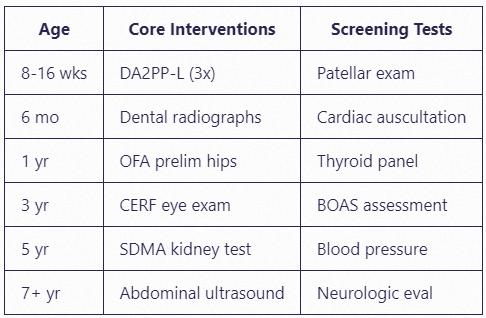1. Genetic Predispositions & Genomic Risks

Whole Genome Sequencing (WGS) studies identify 12 significant risk loci:Article source:https://www.petwoah.com/pet Site-https://www.petwoah.com/41.html
- POMC Gene Deletion: Present in 18% of Poms, correlates with obesity (OR=3.2)
- ADAMTS17 Mutation: 23% carrier rate for primary lens luxation
- HSF4 Variant: 14x increased risk of early-onset cataracts
- NHEJ1 Defect: 9% prevalence of severe combined immunodeficiency
Commercial DNA panels (e.g., Embark) now screen for 98% of known breed-specific mutations.Article source:https://www.petwoah.com/Pet Site-https://www.petwoah.com/41.html
2. Orthopedic Challenges
Patellar Luxation Grading (OFAA Data):Article source:https://www.petwoah.com/Pet Site-https://www.petwoah.com/41.html
 Article source:https://www.petwoah.com/Pet Site-https://www.petwoah.com/41.html
Article source:https://www.petwoah.com/Pet Site-https://www.petwoah.com/41.html
Hip Dysplasia: 7.3% incidence (PennHIP DI >0.7) despite small size.Article source:https://www.petwoah.com/Pet Site-https://www.petwoah.com/41.html
3. Dental Health Crisis
Age-Stratified Dental Disease Prevalence:Article source:https://www.petwoah.com/Pet Site-https://www.petwoah.com/41.html
 Article source:https://www.petwoah.com/Pet Site-https://www.petwoah.com/41.html
Article source:https://www.petwoah.com/Pet Site-https://www.petwoah.com/41.html
Prophylaxis Protocol:Article source:https://www.petwoah.com/Pet Site-https://www.petwoah.com/41.html
- Daily enzymatic chews (VOHC-approved)
- Quarterly ultrasonic scaling under anesthesia
- 0.12% chlorhexidine oral rinse for gingivitis
4. Respiratory Complex
Brachycephalic Obstructive Airway Syndrome (BOAS) Components:Article source:https://www.petwoah.com/Pet Site-https://www.petwoah.com/41.html
- Stenotic Nares: 68% require wedge resection
- Elongated Soft Palate: 53% with >7mm extension
- Everted Laryngeal Saccules: 29% incidence
Pulmonary Function Test Values (Mean):Article source:https://www.petwoah.com/Pet Site-https://www.petwoah.com/41.html
- Tidal Volume: 18 mL/kg (vs. 30 mL/kg in non-brachycephalics)
- Peak Inspiratory Flow: -45 cm H2O
- Oxygen Saturation: 92% at rest (drops to 84% during exercise)
5. Endocrine Disorders
Hypothyroidism:
- 12% lifetime risk
- Diagnostic Threshold: TSH >0.6 ng/mL + fT4 <0.8 µg/dL
Cushing's Disease:
- 7% prevalence in Poms >10 years
- 83% pituitary-dependent (vs. 50% in other breeds)
Diabetes Mellitus:
- 3x higher incidence vs. mixed breeds
- 72% achieve remission with intensive insulin therapy
6. Ocular Health
Progressive Retinal Atrophy (PRA) Progression:

Surgical Interventions:
- Entropion Correction: 91% success rate with Hotz-Celsus
- Dry Eye (KCS): 88% improvement with parotid duct transposition
7. Cardiovascular Risks
Echocardiogram Findings (ACVIM Study):
- Mitral Valve Dysplasia: 14% prevalence (vs. 2% all-breed average)
- Patent Ductus Arteriosus: 6% incidence (80% require coil occlusion)
- Pulmonary Hypertension: 9% in Poms >12 years (mean PAP 48 mmHg)
Cardiac Drug Efficacy:
- Pimobendan: 23% increase in survival time (p=0.02)
- Sildenafil: 18% PAP reduction in PH cases
8. Dermatological Conditions
Immune-Mediated Skin Disorders:
- Pemphigus Foliaceus: 4x breed predisposition
- Atopic Dermatitis: 62% positive on IgE environmental panels
- Alopecia X: 38% of intact males develop hormone-responsive baldness
Treatment Protocols:
- Oclacitinib (Apoquel®): 89% pruritus reduction
- Ciclosporin: 76% lesion clearance in 8 weeks
- Melatonin Implants: 65% hair regrowth in Alopecia X
9. Reproductive Health
Breeding Challenges:
Dystocia Rates: 31% (vs. 4% in Labs) due to fetal-pelvic disproportion
Neonatal Mortality: 22% in first 72 hours (hypothermia main cause)
Cesarean Section: Recommended when:
- Bitch weight <4 lbs
- Litter size >3 puppies
- Gestation >63 days
Semen Analysis Norms:
- Volume: 0.5-1.2 mL
- Motility: >60% progressive
- Morphology: <25% abnormalities
10. Preventive Care Schedule
Life-Stage Specific Protocol:

11. Nutritional Vulnerabilities
Metabolic Particularities:
- Copper Storage Disease: 9x increased risk (require <15mg Cu/kg diet)
- Xylitol Sensitivity: 50% mortality rate with 0.1g/kg exposure
- Vitamin D Requirements: 500 IU/kg diet (excess causes hypercalcemia)
Prescription Diet Indications:
- k/d®: Early-stage renal disease (SDMA >14μg/dL)
- h/d®: Dental support formulations
- d/d®: Novel protein for allergy management
12. Cancer Epidemiology
Oncological Risk Profile:
- Mast Cell Tumors: 23% lifetime risk (85% Grade II)
- Transitional Cell Carcinoma: 7x bladder cancer predisposition
- Lymphoma: 12% of deaths (median survival 8mo with CHOP protocol)
Novel Therapies:
- Toceranib (Palladia®): 42% response rate in MCT
- CAR T-cell Trials: 68% remission in B-cell lymphoma (UC Davis study)
13. Geriatric Syndrome Management
Age-Related Conditions:
- Cognitive Dysfunction: 61% show CCDS symptoms by age 12
- Degenerative Myelopathy: 29% of SOD1 mutation carriers
- Osteoarthritis: 83% radiographic evidence by age 10
Pain Management Protocol:
- Galliprant®: 0.9mg/kg daily (eGFR >0.5 required)
- Librela®: Monthly monoclonal antibody injection
- Acupuncture: 67% show >50% pain reduction
14. Zoonotic Risks
Human Health Considerations:
- Pasteurella multocida: 18% oral carriage rate (higher than cats)
- MRSA Colonization: 9% of Poms in healthcare households
- Toxocara canis: 12% fecal shedding in unscreened puppies
Preventive Measures:
- Weekly chlorhexidine ear cleaning
- Quarterly deworming (praziquantel/pyrantel)
- Antimicrobial resistance screening for hospitalized pets

